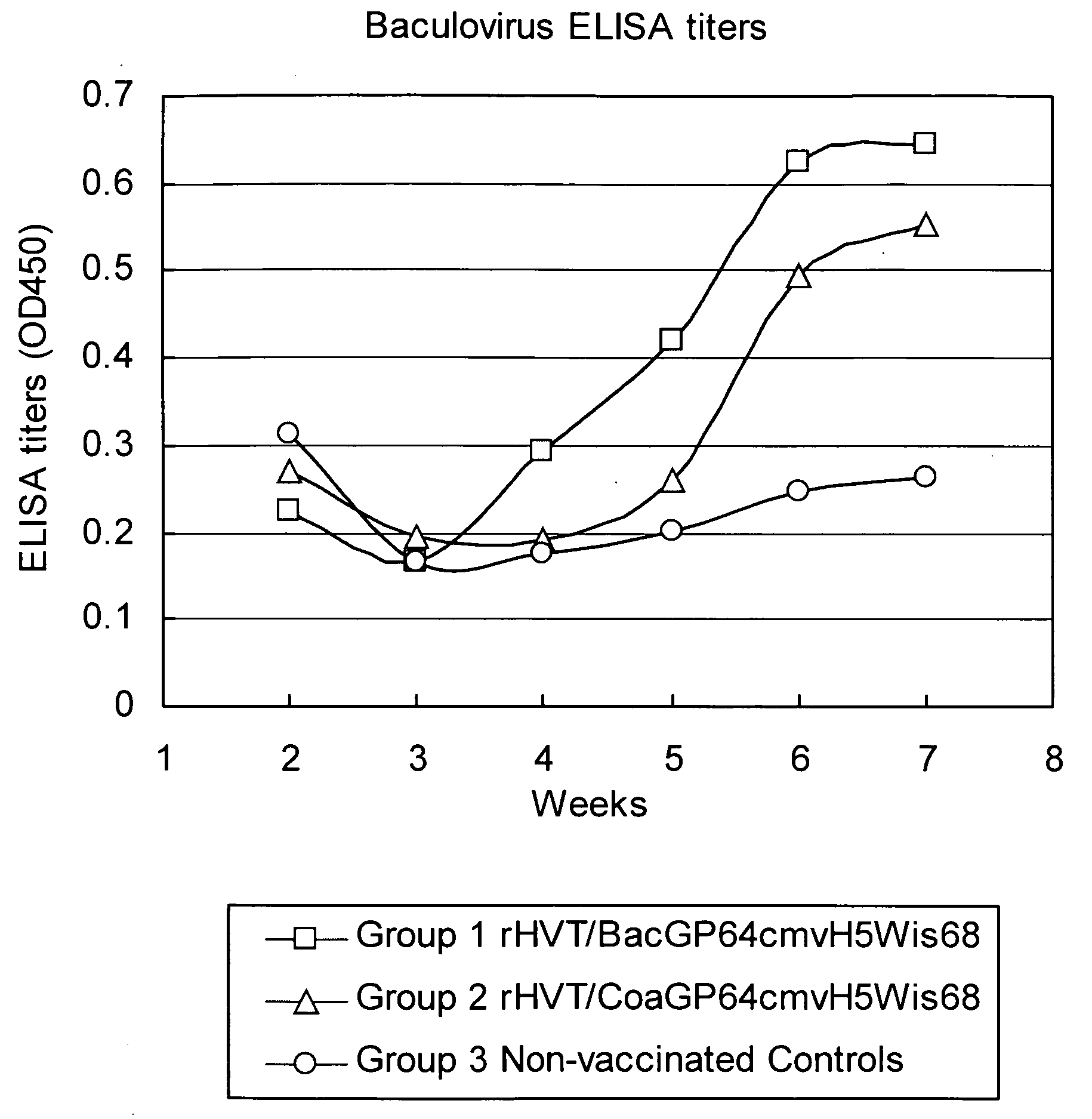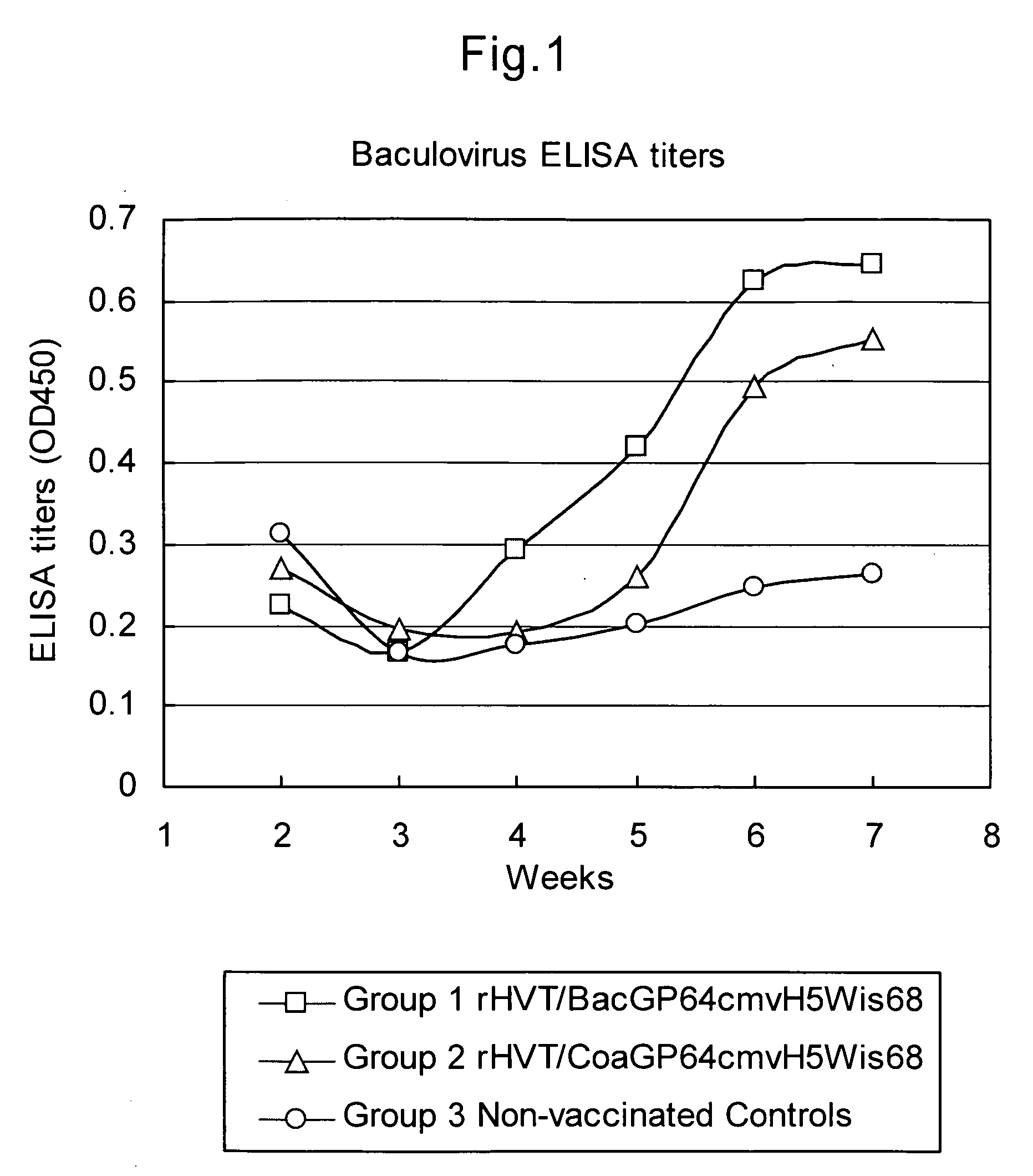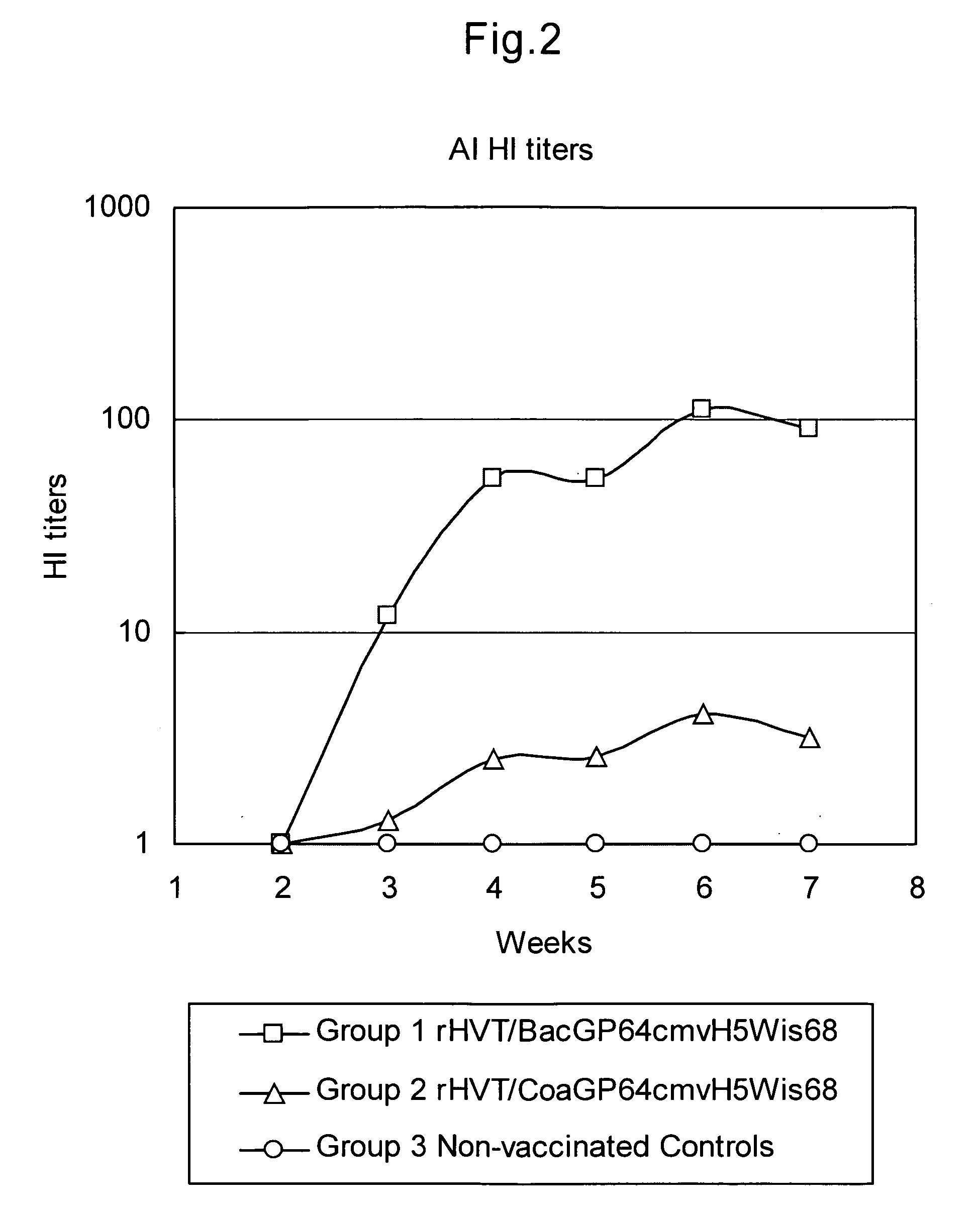Avian vaccines possessing a positive marker gene
a technology of positive marker and avian vaccine, which is applied in the direction of viruses/bacteriophages, antibody medical ingredients, dsdna viruses, etc., can solve the problems of inability to distinguish between antibodies produced, vaccines may not be properly administered to individual animals, and cannot be easily identified and tracked. , to achieve the effect of easily identifying and tracking vaccinated animals
- Summary
- Abstract
- Description
- Claims
- Application Information
AI Technical Summary
Benefits of technology
Problems solved by technology
Method used
Image
Examples
example 1
Cloning of gp64 Gene from Baculovirus (AcNPV)
[0029]The DNA of Baculovirus (Autographa californica nuclear polyhedrosis virus; AcNPV) was commercially available (Orbigen, Inc., Cat. #: BVD-10001). To obtain gp64 gene fragments from AcNPV, polymerase chain reaction (PCR) was conducted using Ex Taq Polymerase (TAKARA BIO INC., Shiga 520-2193, Japan, Cat#: RR001A) and with two kinds of PCR primer sets. One pair was GP64-F1 (SEQ ID NO. 3) and GP64-R2 (SEQ ID NO. 4), and amplified 857-basepair (bp) DNA fragment. The other pair was GP64-F2 (SEQ ID NO. 5) and GP64-R1 (SEQ ID NO. 6), and amplified 724-bp DNA fragment. To connect the resulting two DNA fragments, the reaction mixtures were mixed as a new template, and the next CR was performed using the primer set of GP64-F1 (SEQ ID NO. 3) and GP64-R1 (SEQ ID NO. 6). The amplified 1.55 kilobase (kb) gp64 DNA was inserted into pCR2.1-TOPO vector (Invitrogen, Cat.#: K4500-01), resulting in pCR2.1-GP64. Nucleotide sequences of the gp64 genes in f...
example 2
Cloning of pp34 Gene from Baculovirus (AcNPV)
[0031]To obtain pp34 gene fragments from AcNPV, PCR was conducted using Pfu DNA Polymerase (Stratagene, Cat.#: 600153) and with a PCR primer set of pp34-F primer (SEQ ID NO. 11) and pp34-R primer (SEQ ID NO. 12). The amplified 784-bp pp34 DNA was inserted into pPCR-Script Amp vector (Stratagene, Cat.#: 211188), resulting in pPCR-pp34. Nucleotide sequences of the pp34 genes in two candidate clones of the plasmid pPCR-pp34 were determined using Beckman Sequencer CEQ2000 (Beckman) with four primers; M13 Forward primer (SEQ ID NO. 7), M13 Reverse primer (SEQ ID NO. 8), pp34-F (SEQ ID NO. 11), and pp34-R (SEQ ID NO. 12). The sequences in both of two clones were identical to that of pp34 gene registered in GeneBank (Acc.#: NC-001623). The nucleotide sequence and the deduced amino acid sequence of the cloned pp34 gene are shown in SEQ ID NO. 13 and NO.14
example 3
Construction of Homology Vectors
[0032]3-1. Construction of an Intermediate Plasmid p46Sfi
[0033]HVT-DNA was prepared as described in Example 1 of U.S. Pat. No. 6,632,664. A new SfiI restriction enzyme site into which foreign genes were inserted, was generated by PCR in vitro mutagenesis using two primer pairs. The primer pairs were HVT45Sph (SEQ ID NO. 15) and 45SfiR (SEQ ID NO.16), and 46SfiF (SEQ ID NO. 17) and HVT46Xho (SEQ ID NO. 18). Two PCR reactions were conducted separately using each pair of primers and HVT-DNA as a template. Then two PCR products (0.4 kb and 0.6 kb, respectively) were mixed and used as a template for the secondary PCR with a primer pair of HVT45Sph (SEQ ID NO. 15) and HVT46Xho (SEQ ID NO. 18), yielding the 0.98 kb fragment. The amplified fragment was digested with Sphl and Xhol and inserted into Sphl and Xhol digested pNZ45 / 46Sfi (Example 2 of U.S. Pat. No. 6,632,664), resulting in p46Sfi.
3-2. Construction of p46Bac
[0034]Two synthetic oligonucleotides, Sfi-...
PUM
| Property | Measurement | Unit |
|---|---|---|
| time | aaaaa | aaaaa |
| temperature | aaaaa | aaaaa |
| pH | aaaaa | aaaaa |
Abstract
Description
Claims
Application Information
 Login to View More
Login to View More - R&D
- Intellectual Property
- Life Sciences
- Materials
- Tech Scout
- Unparalleled Data Quality
- Higher Quality Content
- 60% Fewer Hallucinations
Browse by: Latest US Patents, China's latest patents, Technical Efficacy Thesaurus, Application Domain, Technology Topic, Popular Technical Reports.
© 2025 PatSnap. All rights reserved.Legal|Privacy policy|Modern Slavery Act Transparency Statement|Sitemap|About US| Contact US: help@patsnap.com



